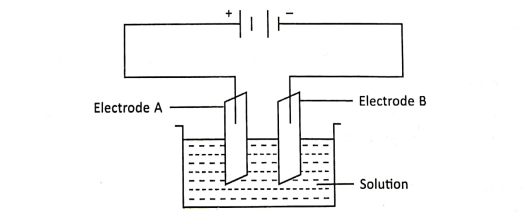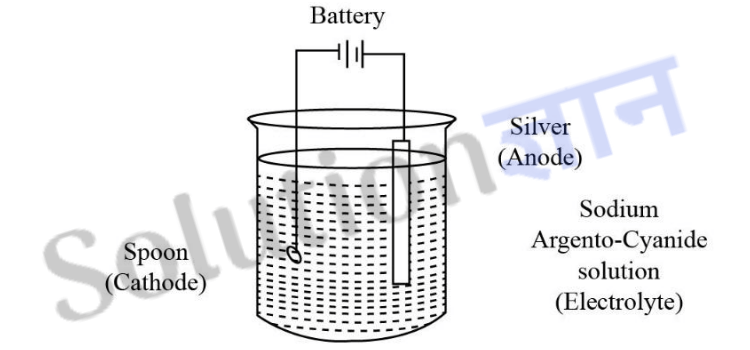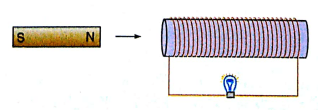DAV Class 8 Science Chapter 16 Solutions Electric Current and Its Chemical Effects of The Living World Science Book guides you with the answers to the questions given in the textbook. Class 8 is an important phase of the student’s life as they are introduced to many new concepts that are essential to set strong basics foundation for the topics to be taught in Class 9.
While solving chapter 16 DAV science textbook questions, students often face several doubts and eventually get confused. To help class 8 students clear all their doubts instantly, DAV Class 8 Science Chapter 16 question answer Electric Current and Its Chemical Effects come as a great resource. Here, the detailed Solutions for Class 8 Science Chapter 16 of Science book are given below.
DAV Class 8 Science Chapter 16 Electric Current and Its Chemical Effects
DAV Class 8 Science chapter 16 question answer Electric Current and Its Chemical Effects is given below. Here DAV Class 8 Science Chapter 16 solutions is provided with great explanation. To score very good marks in the DAV Class 8 examination students should solve the questions provided at the end of chapter 16 Electric Current and Its Chemical Effects.
Highlights
- Fill in the blanks.
- True or False
- Tick the correct option.
- Answer the following questions in brief.
- Answer the following questions.
These DAV Class 8 Science Chapter 16 Solutions Electric Current and Its Chemical Effects will help you in scoring good marks as they cover important concepts in different patterns like fill in the blanks, tick the correct option, Match the following, Answer the following questions in brief and Answer the following questions.
DAV Class 8 Science Chapter 16 Solutions
A. Fill in the blanks.
1. Most liquids, that conduct electricity, are solutions of ___________, ___________ and ___________.
2. The ___________ the concentration of an ion in the solution, the greater is the conductivity of the solution.
3. The passage of an electric current, through a solution, can cause ___________ effects.
4. When electric current is passed through copper sulphate solution, copper gets deposited on the plate connected to the ___________ terminal of the battery.
5. The process, in which electricity is used to deposit a thin layer of any desired metal on another metallic object, is known as ___________.
6. The faster is the relative motion between the magnet and the (closed) coil, the ___________ is the current that flows through the coil.
Answer: (1) acid, base, salt (2) greater (3) chemical (4) negative (5) electroplating (6) stronger
B. Write True or False for the following statements.
1. A solution of silver nitrate is a good electrolyte.
2. An electrolytic cell consists of a cathode, anode and an electrolyte.
3. Oxygen gets liberated at the anode during the electrolysis of acidified water.
4. Electrorefining is the process of coating one metal on another using an electric current.
5. The phenomenon of ‘Electro-magnetic Induction’ was discovered by the Italian Scientist, Alessandro Volta.
Answer: (1) True (2) True (3) True (4) False (5) False
C. Tick the correct option.
1. The names of four electrolytes are given below: (A) sea water (B) tap water (C) nitric acid (D) oxalic acid Out of these, the weak electrolytes are the ones labelled as-
Answer: B and D
2. Electrolytes conduct electricity due to the movement of-
Answer: positive as well as negative ions.
3. The electrode, connected to the positive terminal of a battery, is known as the-
Answer: anode
4. The phenomenon of decomposition of an electrolyte, when electricity is passed through it, is known as-
Answer: electrolysis
5. The process, of coating of (say) iron with chromium, is known as-
Answer: electroplating
D. Answer the following questions in brief.
1. State the appropriate term, used for a liquid or solution, which can conduct electricity (along with some accompanying chemical changes).
Answer: Electrolyte
2. Distinguish between strong and weak electrolytes. Give two examples of each.
Answer: Strong electrolyte completely dissociates into its ions in a solution, while a weak electrolyte incompletely dissociates into its ions in a solution.
Example:
Strong electrolytes- Nitric acid and sulphuric acid
weak electrolytes- Tap water and oxalic acid.
3. Name the device that converts-
(a) Chemical energy into electrical energy.
Answer: Cell
(b) Mechanical energy into electrical energy.
Answer: Generator
4. Name the scientists who introduced the (scientific) world to the-
(a) voltaic cell
Answer: Alessandro Volta
(b) phenomenon of electrolysis
Answer: Michael Faraday
(c) phenomenon of electro-magnetic induction
Answer: Michael Faraday and Henry
5. An Electrode ‘A’ is connected to the positive terminal while Electrode ‘B’ is connected to the negative terminal of a battery, as shown in the diagram.
(a) Give the names of the Electrodes A and B.
Answer: Electrodes A is anode and Electrodes B is cathode.
(b) Name the process associated with the circuit shown here.
Answer: Electrolysis
(c) Name the gases produced at A and B.
Answer: Oxygen at A and Hydrogen at B.
6. State the meaning of the terms:
(a) Electro-magnetic induction
Answer: The production of electricity (electric current), by a changing magnetic field.
(b) Electrolysis
Answer: The phenomenon of decomposition of an electrolyte, when electricity is passed through it, is known as electrolysis.
(c) Electrodes
Answer: A metal through which an electric current enters, or leaves, an electric cell for a specific electrolysis experimental set-up.
(d) Electrorefining of metals
Answer: Obtaining pure metal from impure metal by electrolysis is called electrorefining of metals.
7. State three uses of the phenomenon of electrolysis.
Answer: The three uses of the phenomenon of electrolysis are:
- Extraction of metals from ores
- Electrorefining of metals
- Electroplating
E. Answer the following questions.
1. Give reasons for the following:
(a) Solid chloride does not conduct electricity while sodium chloride solution conducts.
Answer: Solid sodium chloride does not provide free ions, while its solution provides free ions. Hence, solid sodium chloride does not conduct electricity while its solution conducts electricity.
(b) It is not safe to carry out electrical repairs outdoors during a heavy downpour.
Answer: Rainwater often contains many dissolved salts in it. So, rainwater is a good conductor of electricity. Hence, carrying out electric repairs during a heavy downpour poses the risk of electric shock. So, it is not safe to carry out electric repairs during a heavy downpour.
(c) To carry out electrolysis of water, a few drops of sulphuric acid are (carefully) added to the water.
Answer: Adding a few drops of sulphuric acid makes the water more conducting. So, a few drops of sulphuric acid are carefully added to water while carrying out electrolysis of water.
(d) Kitchen gas burners are often coated with chromium.
Answer: The coat of chromium prevents corrosion of the gas burner. Hence, kitchen gas burners are often coated with chromium.
2. Three electrolytic cells A, B and C are connected with identical bulbs in separate circuits as shown in the diagram. Electrolytic cell A contains sodium chloride solution and Electrolytic cell B contains acetic acid solution. The electrolytic cell C contains distilled water.

(a) In which Set-up will the bulb glow the brightest? Justify your answers.
Answer: In Set-up A, because sodium chloride is a strong electrolyte.
(b) In which Set-up will the glow of the bulb be quite dim? Justify your answers.
Answer: In Set-up B, because acetic acid is a weak electrolyte.
(c) In which Set-up will the bulb not glow at all? Justify your answers.
Answer: In Set-up C, because distilled water is a bad conductor of electricity.
3. Ramit sets-up the circuit shown below for purification of copper:

(a) Name the metals used for Electrodes A and B.
Answer: Impure copper for electrode A and pure copper for electrode B.
(b) Name the process of purification.
Answer: Electrorefining
(c) Name the solution that needs to be used.
Answer: Copper sulphate
4. (a) Define ‘electroplating’. How can steel spoons be plated with silver? Explain with the help of a diagram.
Answer: The process of depositing a thin layer of some desired metal, over some other metallic object, with the help of an electric current is called electroplating.

For this, a plate of pure silver is made the anode, while the steel spoon is made the cathode. When electric current flows through the set-up, pure silver from anode dissociates and gets deposited on cathode. Thus, a coat of silver is applied on the spoon.
(b) State any three uses of electroplating.
Answer: Three uses of electroplating are:
- It makes the surfaces shiny.
- It makes the surfaces durable.
- It prevents corrosion.
5. Describe an experiment to show that we can get electrical energy by using a magnet.
Answer: Take a hollow cylindrical pipe of iron and wind a large number of turns of well insulated copper wire on it. Clean the two ends of the wire and attach a torch bulb/LED to it. Now, take a strong bar magnet and move it rapidly towards the centre of the pipe (without touching it). We find that the bulb glows. However, it glows only for a while and stop glowing as soon as the magnet is stopped. If we now withdraw the magnet away from the coil, we find that the bulb again glows up’ momentarily. We are, thus, getting electricity through this motion of the magnet near/through a coil.

6. A coil of insulated copper wire is connected to a torch bulb. State the likely response of the bulb, if a bar magnet is-
(a) pushed into the coil?
Answer: Bulb glows.
(b) pulled out of the coil?
Answer: Bulb glows.
(c) held stationery within the coil?
Answer: Bulb does not glow.

Nice
do you study in aakash?
Who are you why we should tell you , fool
Yes bro tum bilkul sahi ho lekin pehle uska comment to padh lete ki wo kya keh raha tha…..
Bhy your answer is nice
Can you make the answers short
PERFECT site for educational help 🙂
Loved it! <3
You are so gooood
This link is very helpful for me
Please make the answer short!!
Very nicely ques/ans are provided.Thanks a lot.????????
PERFECT site for educational help ????
Loved it! <3Very nicely ques/ans are provided.Thanks a lot.This link is very helpful for mehttps://youtube.com/shorts/1UFVfjDVZcw?si=uTsBMeJq7xbSLhOm